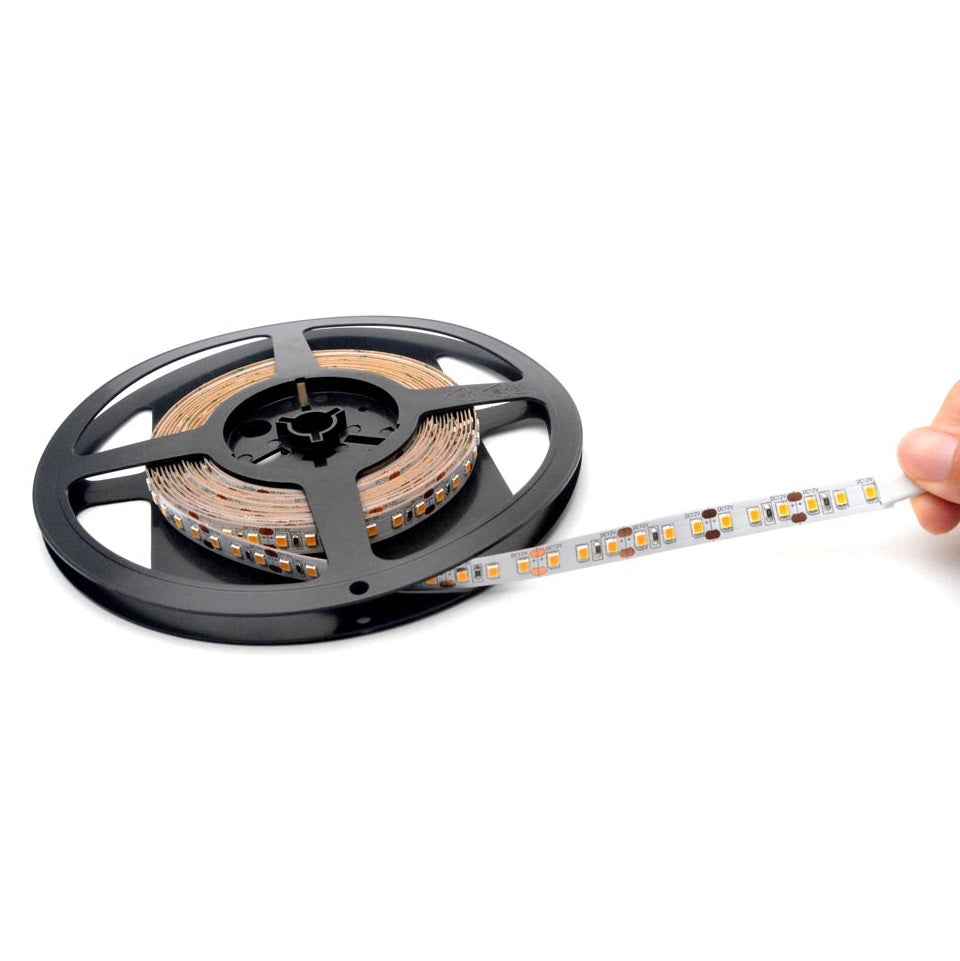What is an LED strip light?
LED strip lights are new and versatile forms of lighting. There are many variants and exceptions but, for the most part, they have the following characteristics:
- Consist of many individual LED emitters mounted on a narrow, flexible PCB
- Operate on low-voltage DC power (5V/12V/24V)
- Are available in a wide range of fixed and variable colours and brightness
- Ship in a long reel (typically 5 metres), can be cut to length, and include double-sided adhesive for mounting.

Voltage Options
Most LED strips are configured to operate at 12V or 24V DC. When running off of a standard mains supply power source (e.g. household wall outlet) at 240V AC, the power needs to be converted to the appropriate low voltage DC signal. This is most frequently and simply accomplished using a DC power supply.
5V - very low available current, so only useful for very short LED strips.
12V - perfect for general strips, lights up to 15m / 150 watts, 3 x LED chips per strip section.
24V - another good option for longer strips 15m+, 6 x LED chips per strip section
Current (amps / wattage)
After choosing your voltage (above) you must ensure your power supply (transformer, adapter) can supply enough current (measured in amps or watts) to supply your LED lights.
Transformers (drivers, adapters)
Make sure that your power supply has enough power capacity to power the LED strips (detailed steps here). Every DC power supply will list its maximum rated current (in Amps) or power (in Watts). Determine the total power draw of the LED strip using the following formula:
- Power = LED power (per metre) x LED strip length (in metres)
Example scenario connecting 5 metres of LED strip where LED strip power consumption is 4 Watts per metre:
- Power = 4 Watts per metre x 5 metres = 20 Watts
Chip types / sizes
LED packages types are designated by four digit codes such as 3528, 5050, 3030 and 2835. The first two digits refer to the width of the package, while the last two digits refer to its length, in tenths of a millimeter. So for example, a 3528 LED package has a width of 3.5 mm, and a length of 2.8 mm.
Density

Colour types
Colour temperature is a way to describe the colour of light emitted by a light source. It is measured in degrees Kelvin, with lower colour temperatures being a warm, yellowish-red colour, and higher colour temperatures taking on a white-bluish tone.

2700K: perfect for bedrooms and other interior applications where a warm, inviting atmosphere is desired
3000K: areas where a slight more energized environment is desired can benefit from 3000K color temperature LED strip lights. Museums, art galleries, restaurants, hotels and other high-end spaces are also great candidates for this.
4000K: the majority of retail fixtures and store interiors, are good places to install 4000K. Commonly considered a midpoint between warm white and cool white, this is a good compromise if you don't like the harshness of cool white but also want to avoid too much yellow in a warm white space.
6500K: applications that need to simulate natural daylight should use 6500K. Film, photography and industrial applications would fall under this category.
Brightness
Brightness of LED strips is determined using the metric lumens. Unlike incandescent bulbs, different LED strips can have different levels of efficiency, so a wattage rating is not always meaningful in determining actual light output.
LED strip brightness is typically described in lumens metre. A good quality LED strip should provide at least 1500 lumens per meter, which provides approximately the same amount of light output per foot as a traditional T8 fluorescent lamp. (eg. 4-ft T8 fluorescent = 4-ft of LED strip = 1800 lumens).
LED strip brightness is primarily determined by three factors:
- Light output and efficiency per LED emitter
- The number of LEDs per metre
- The power draw of the LED strip per metre
An LED strip light without a brightness specification in lumens is a red flag. You will also want to watch out for low cost LED strips that claim high brightness, as they may overdrive the LEDs to the point of premature failure.

Strip types
LED strips are typically available in 5m lengths and can be RGB or single colour.
Waterproof options are great for outdoor installation, look for the following IP ratings.
IP65 - IP rated as "dust tight" and protected against water projected from a nozzle.
IP67 - IP rated as "dust tight" and protected against immersion.
IP68 - IP rated as "dust tight" and protected against complete, continuous submersion in water.
Connection Methods

Aluminium Channel and Heatsinking
Despite their versatility and ease of use, LED strips are nonetheless bare circuitboard components. Mounting the LED strips inside of an aluminum channel, along with a diffuser cover, can significantly improve the aesthetics of a lighting installation.
Aluminium channels are typically long pieces of extruded aluminium in a U or V shape. The LED strip is then secured (using the double-sided tape) at the bottom of the channel. A long piece of frosted polycarbonate plastic (typically provided with the aluminium channel) then snaps onto the top of the channel.
You may have correctly read elsewhere that LEDs need effective thermal management for reliable operation. Higher quality LED strip light products actually underdrive the LEDs, and are designed to last tens of thousands of hours without any heatsinking. During operation, the LED strip can get warm to the touch, but the temperature rise is far below the thermal limits of the LEDs and circuitboard components. (Our products typically exhibit temperature rises of 30 C over ambient temperatures, without any heatsinking).
The aluminium channels may help dissipate the heat from the LED strips, but for the most part they are not necessary for thermal management and are primarily for mounting and diffusion purposes.

Dimming and power control
Unlike LED bulbs, all LED strips are dimmable when paired with the correct equipment. There are two methods of dimming LED strips: an AC TRIAC wall-dimmer, or a DC low-voltage dimmer. The AC TRIAC dimmer approach is typically most ideal for residential and commercial lighting applications where the dimming input signal comes from a traditional wall-switch dimmer. This setup requires a TRIAC dimmable power supply.
A DC low-voltage dimmer or (RGB) controller is typically in the form of a manual or digital dimmer module that is placed between the DC power supply and the LED strip. This approach is best suited for colour changing applications or less permanent lighting installations.
Reference -

